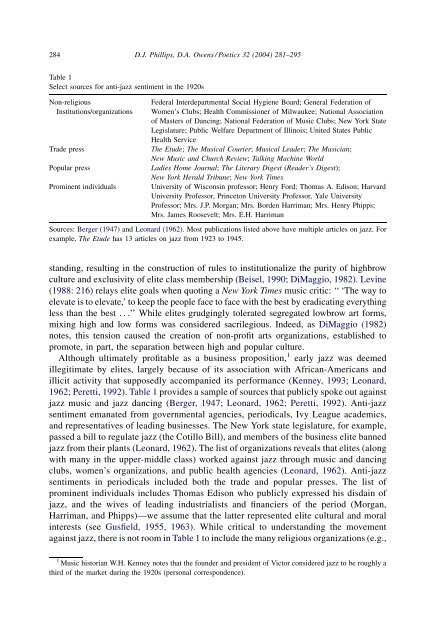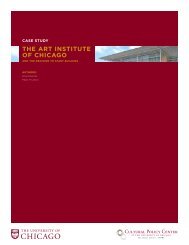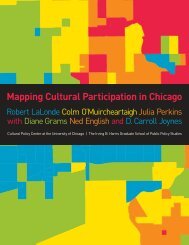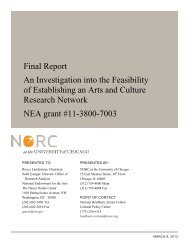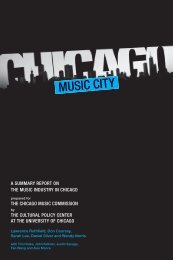Incumbents, innovation, and competence - Cultural Policy Center ...
Incumbents, innovation, and competence - Cultural Policy Center ...
Incumbents, innovation, and competence - Cultural Policy Center ...
Create successful ePaper yourself
Turn your PDF publications into a flip-book with our unique Google optimized e-Paper software.
284 D.J. Phillips, D.A. Owens / Poetics 32 (2004) 281–295<br />
Table 1<br />
Select sources for anti-jazz sentiment in the 1920s<br />
Non-religious<br />
Institutions/organizations<br />
Federal Interdepartmental Social Hygiene Board; General Federation of<br />
Women’s Clubs; Health Commissioner of Milwaukee; National Association<br />
of Masters of Dancing; National Federation of Music Clubs; New York State<br />
Legislature; Public Welfare Department of Illinois; United States Public<br />
Health Service<br />
Trade press The Etude; The Musical Courier; Musical Leader; The Musician;<br />
New Music <strong>and</strong> Church Review; Talking Machine World<br />
Popular press Ladies Home Journal; The Literary Digest (Reader’s Digest);<br />
New York Herald Tribune; New York Times<br />
Prominent individuals University of Wisconsin professor; Henry Ford; Thomas A. Edison; Harvard<br />
University Professor, Princeton University Professor, Yale University<br />
Professor; Mrs. J.P. Morgan; Mrs. Borden Harriman; Mrs. Henry Phipps;<br />
Mrs. James Roosevelt; Mrs. E.H. Harriman<br />
Sources: Berger (1947) <strong>and</strong> Leonard (1962). Most publications listed above have multiple articles on jazz. For<br />
example, The Etude has 13 articles on jazz from 1923 to 1945.<br />
st<strong>and</strong>ing, resulting in the construction of rules to institutionalize the purity of highbrow<br />
culture <strong>and</strong> exclusivity of elite class membership (Beisel, 1990; DiMaggio, 1982). Levine<br />
(1988: 216) relays elite goals when quoting a New York Times music critic: ‘‘ ‘The way to<br />
elevate is to elevate,’ to keep the people face to face with the best by eradicating everything<br />
less than the best ...’’ While elites grudgingly tolerated segregated lowbrow art forms,<br />
mixing high <strong>and</strong> low forms was considered sacrilegious. Indeed, as DiMaggio (1982)<br />
notes, this tension caused the creation of non-profit arts organizations, established to<br />
promote, in part, the separation between high <strong>and</strong> popular culture.<br />
Although ultimately profitable as a business proposition, 1 early jazz was deemed<br />
illegitimate by elites, largely because of its association with African-Americans <strong>and</strong><br />
illicit activity that supposedly accompanied its performance (Kenney, 1993; Leonard,<br />
1962; Peretti, 1992). Table 1 provides a sample of sources that publicly spoke out against<br />
jazz music <strong>and</strong> jazz dancing (Berger, 1947; Leonard, 1962; Peretti, 1992). Anti-jazz<br />
sentiment emanated from governmental agencies, periodicals, Ivy League academics,<br />
<strong>and</strong> representatives of leading businesses. The New York state legislature, for example,<br />
passed a bill to regulate jazz (the Cotillo Bill), <strong>and</strong> members of the business elite banned<br />
jazz from their plants (Leonard, 1962). The list of organizations reveals that elites (along<br />
with many in the upper-middle class) worked against jazz through music <strong>and</strong> dancing<br />
clubs, women’s organizations, <strong>and</strong> public health agencies (Leonard, 1962). Anti-jazz<br />
sentiments in periodicals included both the trade <strong>and</strong> popular presses. The list of<br />
prominent individuals includes Thomas Edison who publicly expressed his disdain of<br />
jazz, <strong>and</strong> the wives of leading industrialists <strong>and</strong> financiers of the period (Morgan,<br />
Harriman, <strong>and</strong> Phipps)—we assume that the latter represented elite cultural <strong>and</strong> moral<br />
interests (see Gusfield, 1955, 1963). While critical to underst<strong>and</strong>ing the movement<br />
against jazz, there is not room in Table 1 to include the many religious organizations (e.g.,<br />
1<br />
Music historian W.H. Kenney notes that the founder <strong>and</strong> president of Victor considered jazz to be roughly a<br />
third of the market during the 1920s (personal correspondence).


